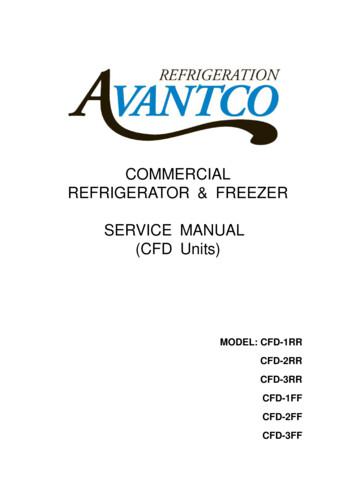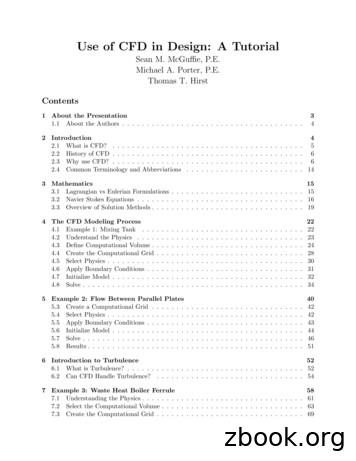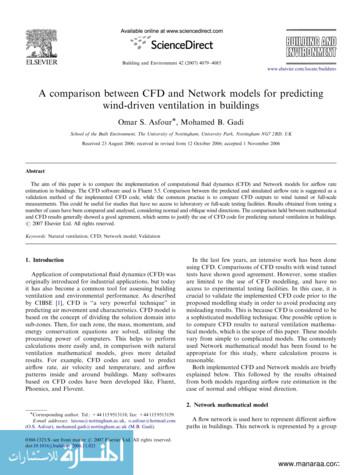Make-Up Air Performance CFD Study - CaptiveAire
Make-Up Air Performance CFD StudyOctober 30, 2003
PURPOSECFD models are useful tools in visualizing airflow and temperature gradients and flow.This CFD (computational fluid dynamics) study was performed on an exhaust onlykitchen hood with a front, perforated make-up air system. The exhaust rate of thehood was held constant to determine how changes in velocity and temperature of themake-up air effect the kitchen.CFD MODEL PARAMETERSTwo CFD models were analyzed in this study. Model number 1 represents a make-upair system that introduces ambient outdoor air into the kitchen space. Model number 2represents a make-up air system with two plenums on the front of the hood. Theplenum closest to the hood (SP1) introduces 95 F ambient outdoor air into the spaceand the second plenum (SP2) introduces 72 F air conditioned air into the system.Exhaust Hood Parameters:Model 5424ND, 8 ft. Long16” Tall Baffle Filters6’6” Hanging Height2400 CFM Exhaust (300 CFM/Ft)6” Left and Right Overhang24” Front OverhangCooking Equipment Parameters:600 F Char broilers6 Burner, 96,000 BTU/Hr Each22.75” Deep x 32” Wide CookingSurface Each36” TallSupply Plenem Paramaters:8 ft. Long6” Tall12” WideRoom Parameters:72 F Ambient Temperature4 ft. Space on Both Sides of HoodNo Wall Opposite Hood WallThe following figures show the CFD model setups. Figures 1 and 3 illustrate the 3-Dmodels used for the analysis and figures 2 and 4 show the plan view of the hood,plenums and the cooking equipment, along with the general space layout.Figure 1. Model Number 1 – Ambient Outdoor Air Supply Plenum2
8’54”48”HOODPSP12”ROOMROOM WALLSFigure 2. Plan View of Model Number 1Figure 3. Model Number 2 – Ambient Outdoor Air Supply and AC Plenum3
8’54”48”HOODPSP (SP1)12”AC PLENUM (SP2)12”ROOMROOM WALLSFigure 4. Plan View of Model Number 2RESULTSThe CFD analysis results are illustrated on the following four pages. The first two pagesillustrate the results of the model 1 analysis and the last two pages illustrate the resultsof the model 2 analysis. Again, model number 1 represents a single supply plenum onthe front of the hood and model number 2 refers to an untempered supply plenum (SP1)along with an air conditioned plenum (SP2), both on the front of the hood.The first set of results for model number 1 show the supply air-stream being introducedat 85 F with a side-by-side comparison of 150 fpm and 200 fpm supply velocity. Thesecond set of results for model number 1 show the supply air-stream being introducedat 95 F with a side-by-side comparison of 150 fpm and 200 fpm supply velocity.The results for model number 2 on the third and fourth page show four scenarios. Allscenarios show untempered supply air (SP1) being delivered at 95 F, and conditionedsupply air (SP2) being delivered at 72 F. There are four cases for each of these sets ofresults showing combinations of 150 fpm and 200 fpm air velocities for each of theplenums.The CFD results are displayed as cross sections of temperature contours in the space( F), supply temperature pathlines ( F), velocity flow pathlines (fpm), and velocityprofiles (fpm). The results of model number 2 are also represented by an 82 Ftemperature contour showing the location of this constant temperature contour in thespace.4
Model Number 1: Supply Air Temperature 85 FSupply Velocity 150 fpmSupply Velocity 200 fpmTemperature Contour ( F)Temperature Contour ( F)Temperature Flow Pathlines ( F)Temperature Flow Pathlines ( F)Velocity Flow Pathlines (fpm)Velocity Flow Pathlines (fpm)Velocity Profile (fpm)Velocity Profile (fpm)5
Model Number 1: Supply Air Temperature 95 FSupply Velocity 150 fpmSupply Velocity 200 fpmTemperature Contour ( F)Temperature Contour ( F)Temperature Flow Pathlines ( F)Temperature Flow Pathlines ( F)Velocity Flow Pathlines (fpm)Velocity Flow Pathlines (fpm)Velocity Profile (fpm)Velocity Profile (fpm)6
Model Number 2: Temperature Contour ( F) SP1 95 F, SP2 72 FVelocity SP1 150 fpm, SP2 150 fpmVelocity SP1 150 fpm, SP2 200 fpmVelocity SP1 200 fpm, SP2 150 fpmVelocity SP1 200 fpm, SP2 200 fpmModel Number 2: Temperature Contour (82 F) SP1 95 F, SP2 72 FVelocity SP1 150 fpm, SP2 150 fpmVelocity SP1 150 fpm, SP2 200 fpmVelocity SP1 200 fpm, SP2 150 fpmVelocity SP1 200 fpm, SP2 200 fpm7
Model Number 2: Velocity Flow Pathlines ( F) SP1 95 F, SP2 72 FVelocity SP1 150 fpm, SP2 150 fpmVelocity SP1 150 fpm, SP2 200 fpmVelocity SP1 200 fpm, SP2 150 fpmVelocity SP1 200 fpm, SP2 200 fpmModel Number 2: Temperature Flow Pathlines ( F) SP1 95 F, SP2 72 FVelocity SP1 150 fpm, SP2 150 fpmVelocity SP1 150 fpm, SP2 200 fpmVelocity SP1 200 fpm, SP2 150 fpmVelocity SP1 200 fpm, SP2 200 fpm8
CONCLUSIONThe CFD analysis shows that kitchen comfort is dependent on the temperature andvelocity of the supply air. In reference to model number 1, these results show that byintroducing hot air (95 F) through the supply plenum at velocities greater than 150 fpm,the circulation of the supply air is promoted back into the exhaust hood. This is due tothe lower density of hot air. Hot air is less dense than cool air and thus has a tendencyto rise in the cooler kitchen environment. Hot air must have a greater discharge velocityto reach the lower edge of the exhaust hood and thus enter the hood instead of thekitchen.There are also noticeable results between 95 F supply air and 85 F supply air. Thecooler 85 F supply air stream results in a much tighter air circulation back into theexhaust hood with less supply air entering the kitchen. As a matter of fact, for modelnumber 1, the single supply plenum, the best results occur when the air is introduced at85 F and 200 fpm discharge velocity. Supply air can be felt by the cook at velocitiesgreater that 150 fpm. Given all of these parameters, the following table illustrates theideal supply plenum velocities at certain temperature ranges.Supply Air Temperature ( F) 5050 to 7575 to 8585 to 95 95Min. Air Velocity (fpm)0140160180200Max. Air Velocity (fpm)140160180200220Based on these results, heating the supply air in cold climates will allow the plenum tosupply more make-up air and cooling the make-up air in hot climates will allow for theplenum to discharge the air at the optimal velocity and have a minimal impact on thekitchen environment.In reference to model number 2, the kitchen environment is effected the least byintroducing the air conditioned air at a velocity equal to or greater than the untemperedsupply air. The best results in this analysis occur when the untempered air is deliveredat 150 fpm and the air conditioned air is delivered at 200 fpm. The air conditioned aircompletely pressurizes the untempered air toward the exhaust hood, thus preventingthe hot air from entering the kitchen. The hot air is forced into the exhaust hood to beexhausted and the cool, air conditioned air is free to mix with the air in the conditionedkitchen.9
at 150 fpm and the air conditioned air is delivered at 200 fpm. The air conditioned air completely pressurizes the untempered air toward the exhaust hood, thus preventing the hot air from entering the kitchen. The hot air is forced into the exhaust hood to be exhausted and the cool, air conditioned air is free to mix with the air in the conditioned
refrigerator & freezer . service manual (cfd units) model: cfd-1rr . cfd-2rr . cfd-3rr . cfd-1ff . cfd-2ff . cfd-3ff . 1 table of contents
430 allocation to elianto cfd o&m 20,577.32 440 allocation to trillium west cfd o&m 27,267.00 450 allocation to west park cfd o&m 70,008.22 460 allocation to festival ranch cfd o&m 177,790.54 480 allocation to tartesso west cfd o&m 27,809.17 481 allocation to anthem sun valley cfd o&
A.2 Initial Interactive CFD Analysis Figure 2: Initial CFD. Our forward trained network provides a spatial CFD analysis prediction within a few seconds and is visualised in our CAD software. A.3 Thresholded and Modified CFD Analysis Figure 3: Threshold. The CFD is thresholded to localise on
performing CFD for the past 16 years and is familiar with most commercial CFD packages. Sean is the lead author for the tutorial and is responsible for the following sections: General Procedures for CFD Analyses Modeling Turbulence Example 3 - CFD Analysis
CFD Analysis Process 1. Formulate the Flow Problem 2. Model the Geometry 3. Model the Flow (Computational) Domain 4. Generate the Grid 5. Specify the Boundary Conditions 6. Specify the Initial Conditions 7. Set up the CFD Simulation 8. Conduct the CFD Simulation 9. Examine and Process the CFD Results 10. F
The CFD software used i s Fluent 5.5. Comparison between the predicted and simulated airflow rate is suggested as a validation method of the implemented CFD code, while the common practice is to compare CFD outputs to wind tunnel or full-scale . Both implemented CFD and Network models are briefly explained below. This followed by the .
Emphasis is on comparing CFD results, not comparison to experiment CFD Solvers: BCFD, CFD , GGNS Grids: JAXA (D), ANSA (E), VGRID (C) Turbulence Models: Spalart-Allmaras (SA), SA-QCR, SA-RC-QCR Principal results: Different CFD codes on same/similar meshes with same turbulence model generate similar results
EFD, CFD, and UA laboratories. EFD labs were improved and UA was introduced. Complementary CFD labs were also introduced using an advanced research code modified for limited user options. From 1999 to 2002, the research CFD code was replaced by the commercial CFD software (FLUENT) and refinements were made and























